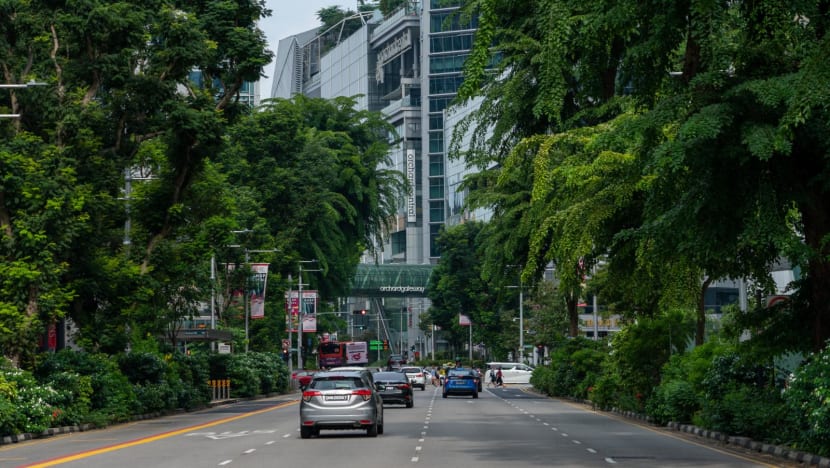Have COE prices peaked? Here’s what analysts say
Premiums for Certificates of Entitlement have fallen after peaking in October. Analysts tell CNA why prices dipped and what to expect in the coming months.

Cars in Orchard Road. (File photo: iStock)

This audio is generated by an AI tool.
SINGAPORE: Those in the market for a new car may have been tempted to take the plunge this week when Certificate of Entitlement (COE) prices fell after repeatedly breaking records.
But buyers might want to hold off on making a beeline to their nearest showroom. Analysts told CNA that prices could dip further, albeit in a volatile market – and perhaps not soon enough for those who need a fresh set of wheels now.
Prices fell across all categories on Wednesday (Dec 20), with Category B, for larger and more powerful cars, at S$110,001 (US$82,600) – down more than S$20,000 from the previous bidding exercise.
Category A, which is for smaller, mass-market cars, slipped from S$88,020 to S$85,000.
To be sure, prices are still much higher than they were in 2018 and 2019, when Category A was below S$30,000.
“There’s going to be a lot of volatility in the short run," said transport economist Walter Theseira.
"But in the medium to longer-term COE premiums should trend downwards as more COE supply comes online.”
Singapore’s Land Transport Authority (LTA) has said the Category A and B COE quota will increase by 35 per cent for the November 2023 to January 2024 period. This was done by bringing forward guaranteed deregistrations of vehicles that were renewed for five years.
“The purpose of this is to try to increase or smooth over the very low COE supply period that we’re having right now,” said Associate Professor Theseira, who is with the Singapore University of Social Sciences.
Besides that, the LTA has also been talking about how more COEs will be available next year.
Prices will fall when this happens, so buyers figure that waiting for the supply to increase – which is expected from late 2024 onwards – is the "best strategy" if you don't need to replace your car right now, he said.
Heart of the Matter podcast: Can families do without a car?
Another reason why prices may have dipped is that many potential buyers have jumped on a plane for a year-end break away from Singapore.
“Showrooms weren’t really crowded, and I think just about everyone we know in Singapore is away for holidays,” said Mr Say, whose company advises electric vehicle brands on expansion in Asia.
Car dealers probably also could not bring in extra vehicles for potential customers even though more COEs are available, he said.
HOW LOW CAN PRICES GO?
Assoc Prof Theseira said inflation and wage growth in Singapore could mean that COE premiums don't fall as low as some may hope.
“I do expect that they will still be significantly higher than what we saw in the late 2010s,” he said. “But whatever it is, it should be lower than the premiums we see today.”
Mr Ng Lee Kwang, board adviser at industrial vehicle leasing company Goldbell Corp, said COE prices could fall for the next couple of years before stabilising. Category A and B could fall to between S$50,000 and S$80,000, he said.
To him, that is the “palatable and acceptable” level for buyers, especially if Singapore starts to charge drivers based on vehicle usage under ERP 2.0 in the future.
“People will say I’m paying this amount as well as usage-based fees,” he said. “Users will tend to calculate.”
The uncertain economic situation could also cause demand to fall, and prices would follow suit, he said.
“It’s not just the quota itself and the (zero car-growth policy). The economic situation plays a part. When the economy is doing well, everybody is buying and changing cars.”
WHAT’S NEXT?
Buyers may have to navigate their way through a rollercoaster ride of rising and falling COE prices, analysts said, as any dramatic drop will cause demand to quickly rise again, pushing premiums back up.
This means that buyers may need to be strategic in trying to determine the best moment to plonk down a deposit on their next ride.
“I would say that, you know, the market is now looking for the new equilibrium,” said One Strategic Consulting’s Mr Say.
“Once the new equilibrium is discovered, probably in the second quarter of the year, then you will probably see a more stable trading pattern.”
Assoc Prof Theseira described it as a “see-saw effect” that is magnified when COE supply is low. Dealers lower prices when COEs are cheaper, only to have to adjust their prices higher when more people buy cars and push COE premiums up again.
That said, the slightly lower COE prices may be a sign that LTA’s efforts to reduce volatility are starting to pay off.
“You reach this point where the market realises if they can hang on for just another year or two, COE supply increases dramatically. Why pay so much for the COE now?” he said.
“I think we have kind of gotten to that point right now, but we can still expect a lot of volatility in the shorter run.”
















